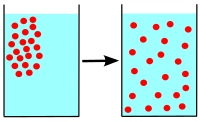
Photo from wikipedia
Abstract Diffusion of 1, 2, 4-trichlorobenzene through polystyrene in the melt state is studied using a rotational rheometer under small amplitude oscillatory shear (SAOS), and the diffusion coefficient D is… Click to show full abstract
Abstract Diffusion of 1, 2, 4-trichlorobenzene through polystyrene in the melt state is studied using a rotational rheometer under small amplitude oscillatory shear (SAOS), and the diffusion coefficient D is measured at various oscillation frequencies, ω0. The effect of solvent concentration C on the polymer complex viscosity η∗ is described using the Fujita-Kishimoto free volume relationship. Free volume parameters A and B are determined separately to diffusion measurements, from melt viscosities of neat and homogeneous solvent-polymer mixtures, and a single parameter fitting is then used to determine the diffusion coefficient. Oscillatory shearing leads to a faster diffusion. This observation is made by comparing the diffusion coefficient of samples subjected to intermittent-type oscillations and those subjected to continuous SAOS. The study clearly confirms that such SAOS measurements can be used to determine the diffusion coefficient with reasonable accuracy as compared to sorption measurements, and shows that the diffusion rate is increased by oscillatory motion.
Journal Title: Polymer
Year Published: 2017
Link to full text (if available)
Share on Social Media: Sign Up to like & get
recommendations!